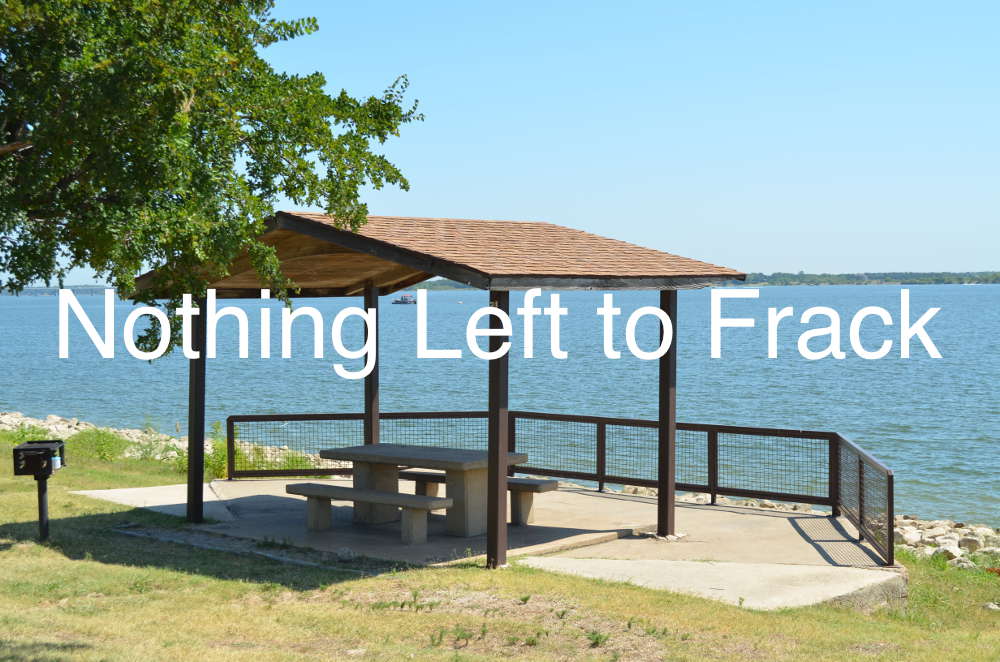
Fracking under water supplies? Seriously, a line has to be drawn somewhere.
We have joined the Center for Biological Diversity, Clean Water Action, and Environment Texas in opposing the sale of more than 3,100 acres of land under and near important lakes and reservoirs that provide cities like Corpus Christi, Brenham and others drinking water. More than 1,400 Sierra Club members and supporters spoke up too! Thank you!
The four organizations submitted formal comments to the BLM office, detailing why leasing these tracts is not in the best interests of Texans. If you are interested in readin them, click here (and here's Exhibit H if you need it).
And below is text from our official joint press release, which highlights the main problems with BLM's proposal.
Environmental groups today called on the Bureau of Land Management to remove over 3,100 acres from an oil and gas lease auction set for the spring over concerns that fracking might trigger earthquakes, damage dams and threaten the water source for half a million Texans. The federal lands are beneath dams that store water supplies for Corpus Christi and Brenham. The public comment period for this lease sale closed Tuesday.
In their letter to BLM, the Center for Biological Diversity, Clean Water Action and Sierra Club raised concerns that oil and gas drilling and hydraulic fracturing or “fracking” on the lands would put dam infrastructure and drinking water supplies at risk from wastewater injection underneath or near water supply lakes. Fracking also poses risks to sensitive fish and wildlife and recreational areas, including important state park resources.
The BLM has jurisdiction over the leasing of all onshore federal mineral rights. All nine of the Texas parcels for sale are below or near drinking water supply lakes. Specifically, Choke Canyon and Lake Texana are two of Corpus Christi’s three main water supply lakes, providing more than half a million people with drinking water. Somerville Lake is a major water supply for the city of Brenham.
Using earthquake data and proven petroleum industry techniques to characterize subsurface characteristics, former senior oil and gas geologist and GIS expert Gerald Bartz developed earthquake tremor risk maps for these parcels. These maps revealed multiple lineaments, or fractures, along the earth’s surface — indicative of possible faults — underlying the water supply lakes and parcels up for auction.
“Fracking, which involves injecting water and chemicals at high pressure below ground, could increase pressure along these fractures and cause underground rocks to shift, resulting in infrastructure damage and earthquakes. There are multiple fractures located directly in the line of the proposed lease parcels,” Bartz said.
Increased fracking and wastewater disposal around the dams could worsen seismic activity around Choke Canyon Reservoir. According to a map prepared by Bartz, earthquakes of magnitudes 2.5 to 4.8 occurred near the footprint of Choke Canyon and in the neighboring counties of the Eagle Ford Shale, a major center for fracking. A 4.8 magnitude earthquake occurred in 2011 less than 30 miles away and a 3.8 magnitude earthquake occurred in 2012 less than 12 miles away from the center of the lake.
“In other words, though drilling has occurred near Choke Canyon to date without damage to this reservoir, there is a tipping point by which added induced seismicity can cause a breach or major infrastructure damage,” said Rita Beving of Clean Water Action. “These water supply lakes are from 30 to almost 50 years old. They were never designed to withstand the kind of induced seismicity that additional fracking and wastewater injection could impose.”
A 2013 presentation by an Army Corp of Engineers senior geotechnical engineer noted potential risks that drilling, injection, extraction and fracking may pose for reservoir structures and their water supplies, including a dam breach.
“The BLM has never looked at whether fracking or fracking-induced earthquakes could worsen the risk of a breach on any of these lakes, or the possible contamination of these drinking water supplies,” said Wendy Park, an attorney with the Center for Biological Diversity. “The BLM needs to remove these parcels from this sale and put the health and safety of Texas communities first, before the financial interests of the oil and gas industry.”
“These lakes are some of the state’s most valuable assets,” said Cyrus Reed, conservation director of the Lone Star Chapter of Sierra Club. “In addition, they provide recreational opportunities for thousands of Texans, including families, and Boy Scouts and Girl Scouts, who come to hike, camp, fish, boat and bird watch. Though some drilling has already gone on around these lakes, concern is mounting over the cumulative impacts that additional fracking may have on reservoir impoundments, and over the potential links between fracking and fault slippage due to deep injection and drilling activities.”